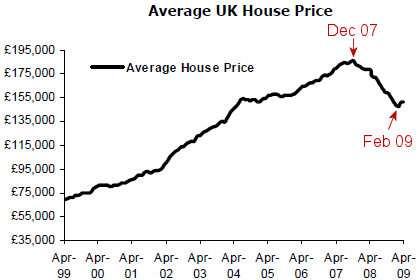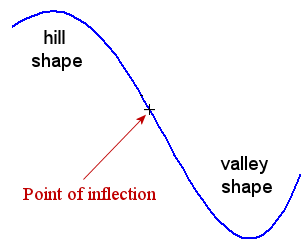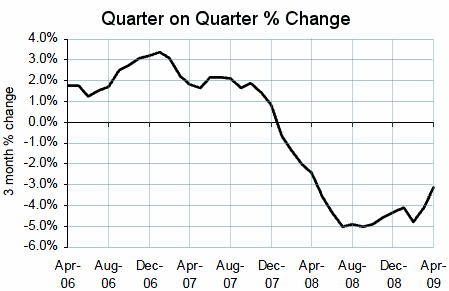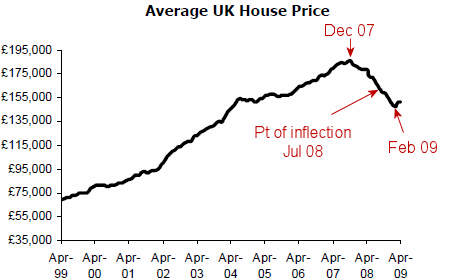Point of inflection for house prices?
By Murray Bourne, 31 May 2009
Everyone is hoping that we’ve seen the worst of the GFC (global financial crisis). There’s a lot of talk about the "green shoots" of an economic recovery that (many hope) is already underway.
News reports often use the term "point of inflection" to mean the point where the worst is over and things are starting to turn around. Let's see what "point of inflection" really means.
As an example, we'll look at house prices. In the USA, England and many other countries, house prices rose very quickly during the years 2001 to 2007, when interest rates were very low. As the financial crisis began to unfold, house owners began panic selling, which drove down prices.
This graph shows UK house prices peaked in Dec 07 and fell until Feb 09 (source no longer available). There has been a small uptick in prices since then.

So is Feb 09 the "point of inflection" for this curve? Actually, no.
A point of inflection is the point where a concave down curve ("hill-shape" – like the months around Dec 07 in the graph above) becomes a concave up curve ("valley-shape" – like the shape of the region near Feb 09) – and vice-versa.
So we are looking for the point where a "hill shape":

becomes a "valley shape":

The point of inflection in the following graph is marked with a cross:

[Using technical terms from calculus, a point of inflection occurs where the second derivative is zero and changes sign from negative (hill shape) to positive (valley shape) and vice-versa.]
In other words, the point of inflection is the point where things are still getting bad, but not getting bad quite so quickly. Eventually, if things keep going the way they are, the bottom of the valley will be reached and we can expect (or hope for) growth in house prices from there. Such growth in house prices is important (especially in the USA case), because it will indicate the worst is over and the world economy should start to pick up again.
Rate of Change Graphs
It’s not very clear where the point of inflection actually is in the UK house price graph above. One way of seeing if we actually have a point of inflection would be to look at the change graph. If we can find a point where the change has bottomed out, then we will have found a point of inflection in the house price graph.
The following graph shows the quarter on quarter (3 months) change in UK house prices [Source: Nationwide (no longer available)]. We don't use month-on-month changes because they are too volatile.
We see that up to Dec 07, the percent change in house prices is positive. In Dec 07, the change passed through 0%, and after that the percent change turned negative (house prices were dropping).

We can see that "maximum negativity" of just over −5% was reached in Jul 08 and from there the percent change appears to be improving. It's still negative by Apr 09, but not as bad at −3%.
[In calculus terms, there will be a point of inflection when the rate of change is at a minimum (or maximum). That is, the derivative of the rate of change is 0 and changes sign from negative to positive.]
When the quarter on quarter change turns positive, there will be greater confidence in the overall UK economy.
Question: In the house price graph at the top, we can see a small increase in prices after Feb 09. Why hasn't the percent change graph turned positive?
Answer:Remember, this is a quarter on quarter change, so trends are smoothed out. If we were looking at a month on month graph, the last 2 data points for Mar and Apr 09 would be positive.
We return to our original graph and indicate where the point of inflection appears to be, in Jul 08. As you can see, things still got worse after this point, but not as badly. House prices appear to have turned around in Feb 09, the "bottom of the valley".

At the time of writing, US house prices are still on the way down and not showing much evidence of an inflection point yet. According to S&P/Case-Shiller Home Price Indices (link no longer active):
Minneapolis had a record monthly decline of 6.1% in March. This represents the largest monthly decline of any metro area in the history of the indices.
As affordability improves, house buyers will begin to re-appear. Let's hope so — the world needs it.
Be the first to comment below.
